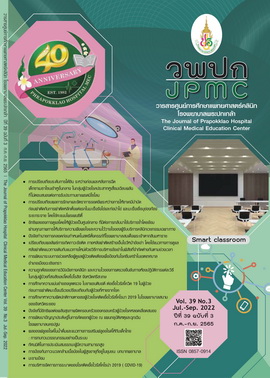Predicting Factors Associated with Preterm Birth of Pregnant Women at Somdejphrajaotaksinmaharaj Hospital
Main Article Content
Abstract
BACKGROUND: Preterm birth was the condition in which a pregnant woman has childbirth before 37 weeks of gestation. The effects of preterm birth can lead to disabilities and disabilities for surviving babies, a significant problem in public health and obstetrics-gynecology at present.
OBJECTIVES: To study predicting factors associated with preterm birth of pregnant women at Somdejphrajaotaksinmaharaj Hospital.
METHODS: This research was a case-control study. The data collection period was three years (Fiscal Year 2019–2021). The sample group was divided into (1) the study group: 155 women who had a preterm birth, and a control group: 347 pregnant women who could stop preterm birth and maintained an average term birth. The research instrument was a pregnant women’s data record designed by the researcher. Data analysis by using descriptive statistics, univariable and multiple logistic regressions with the statistical significance at 0.05.
RESULTS: The most samples were 27.1±6.3 years old, Gestational Age (GA) of labor pain at 33.5±3.0 weeks, and BMI before pregnancy was 23.3±4.7 kg/m2. Factors that could predict preterm birth in pregnant women include: (1) premature rupture of the membrane was found to have preterm birth 3.59 times (95%CI:2.32-5.55), and (2) cervical length less than 2.5 centimeters were found to have preterm birth 5.08 times (95%CI: 3.22–8.04).
CONCLUSIONS: Premature rupture of the membrane and cervical length were predicting factors associated with preterm birth of pregnant women. Therefore, to prevent preterm birth in pregnant women in the future, we should set guidelines for the surveillance and following of pregnant women by considering to these factors.
Article Details

This work is licensed under a Creative Commons Attribution-NonCommercial-NoDerivatives 4.0 International License.
References
Samuel TM, Sakwinska O, Makinen K, Burdge GC, Godfrey KM, Silva-Zolezzi I. Preterm birth: a narrative review of the current evidence on nutritional and bioactive solutions for risk reduction. Nutrients [Internet]. 2019 [cited 2020 June 10];11(8):1811. Available from: https://www.mdpi.com/2072-6643/11/8/1811/htm
Ministry of Public Health. Thailand medical services profile 2015-2018. 2nd ed. Nonthaburi: Department of Medical Services; 2018.
Wanitpongpan P, Russameecharoen K, Lertbunnaphong T. Modern text book of obstetrics. Bangkok: Department of Obstetrics and Gynecology, Faculty of Medicine Siriraj Hospital, Mahidol University; 2017.
Chalermvuttanon R, Ratchaputi A, Chotikasathit S. Factors associated with preterm birth among pregnant women at Ranong Hospital. Reg 11 Med J 2016,30:291-8.
Yatrongjit N. Predicting factors associated with preterm birth after receiving stopping preterm labor treatment. Journal of Nakornping Hospital 2019,10(1):25-34.
Alijahan R, Hazrati S, Mirzarahimi M, Pourfarzi F, Ahmadi Hadi P. Prevalence and risk factors associated with preterm birth in Ardabil, Iran. Iran J Reprod Med 2014;12:47-56.
Muhumed II, Kebira JY, Mabalhin MO. Preterm birth and associated factors among mothers who gave birth in Fafen Zone Public Hospitals, Somali Regional State, Eastern Ethiopia. Research and Reports in Neonatology 2021;11:23-33.
Jelliffe-Pawlowski LL, Rand L, Bedell B, Baer RJ, Oltman SP, Norton ME, et al. Prediction of preterm birth with and without preeclampsia using mid-pregnancy immune and growth-related molecular factors and maternal characteristics. J Perinatol 2018;38:963-72.
Somdejphrajaotaksinmaharaj Hospital. Hospital report 2016-2019. Tak: Data Center, Somdejphrajaotaksinmaharaj Hospital; 2020.
Huang J, Qian Y, Gao M, Ding H, Zhang L, Jia R. Analysis of factors related to preterm birth: a retrospective study at Nanjing Maternity and Child Health Care Hospital in China. Medicine (Baltimore) [Internet]. 2020 [cited 2021 Aug 6];99(28):e21172. Available from: https://www.ncbi.nlm.nih.gov/pmc/articles/PMC7360194/pdf/medi-99-e21172.pdf
Wang Y, Ding J, Xu HM. The predictive value of cervical length during the second trimester for non-medically induced preterm birth. Int J Gen Med 2021;14:3281-5.
Sooklim R, Krajangpong K, Cheawchusak W. The prevalence and pregnancy outcomes of short cervix in low risk singleton pregnancy from universal cervical length screening. Vajira Medical Journal: Journal of Urban Medicine 2020,64:23-32.
Wichasilp U. Comparison of transabdominal and transvaginal cervical length measurement in obstetric women at Nakornping Hospital. Journal of Nakornping Hospital 2017,8(2):11-20.
Netsirininkul T, Termsarasab C, Kongkit N, Sennunta P, Techawong C, Suanpoot S. Comparison study of cervical lengths between preterm and term pregnant women among the low-risk women with normal mid-trimester cervical lengths. Lampang Med J 2020,41:49-57.
Taeger D, Kuhnt S. Statistical hypothesis testing with SAS and R. West Sussex: John Wiley & Sons; 2014.

